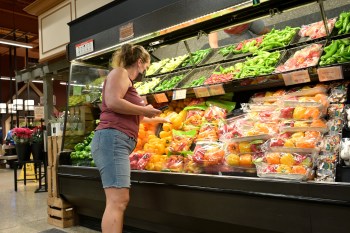About 45 million Americans depend on food stamps to buy their groceries, according to the latest government data. That means about 15 percent of the U.S. population relies on at least some federal assistance to buy food and groceriess for their family each week.
At a cost to tax payers of about $75 billion a year – nearly double what is was the last presidential election year – it’s no wonder the government’s Supplemental Nutrition Assistance Program, or SNAP, has become a real issue this election issue.
In August 2011, we put together an Interactive Map that examines the use of SNAP state by state. Using data as new as May 2011, we ranked each state by the number of SNAP recipients in 2011 and 2010, as well as by the percent of change in that time span.
The results were interesting, though not all that surprising. In North Dakota, where the economy is humming, food assistance use is just about flat, dipping a modest 0.01 percent year over year. At the opposite end of the spectrum, in Alabama, food stamp use has more than doubled; up 118 percent to be precise.
TOP 10 States Ranked by % Increase in Nutrition Assistance:
May 2011 compared to May 2010
1. Alabama, 118.1% year-over-year increase
2. North Carolina, 20.4% year-over-year increase
3. New Jersey, 20.4% year-over-year increase
4. Minnesota, 19.1% year-over-year increase
5. Delaware, 19.1% year-over-year increase
6. Maryland, 18.6% year-over-year increase
7. Nevada, 18.6% year-over-year increase
8. Florida, 17% year-over-year increase
9. Idaho, 16.1% year-over-year increase
10. New Mexico, 15.4% year-over-year increase
When we released this Map, some readers noted that the data can be a bit deciptive at face value. For example, Texas recorded the highest number of SNAP participants in May 2011 at 3.95 million. But for a state with nearly 25 million residents, Texas doesn’t look so bad when compared to Florida, which recorded 3.6 million SNAP participants among its population of 18.5 million.
Also, Alabama’s skyrocketing numbers were mostly the result of a series of devastating tornadoes at the end of April, which promoted many families to receive one-time payments for disaster relief.
There’s a lot happening in the world. Through it all, Marketplace is here for you.
You rely on Marketplace to break down the world’s events and tell you how it affects you in a fact-based, approachable way. We rely on your financial support to keep making that possible.
Your donation today powers the independent journalism that you rely on. For just $5/month, you can help sustain Marketplace so we can keep reporting on the things that matter to you.

















